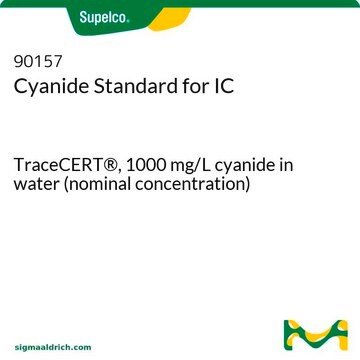About This Item
Recommended Products
grade
ACS reagent
Quality Level
vapor density
1.7 (vs air)
vapor pressure
1 mmHg ( 817 °C)
Assay
≥95.0%
form
crystalline powder
powder, crystals or chunks
pH
11-12 (25 °C, 49 g/L)
mp
563.7 °C (lit.)
solubility
water: soluble(lit.)
anion traces
S2-: ≤0.005%
SCN-: ≤0.02%
chloride (Cl-): ≤0.15%
phosphate (PO43-): ≤0.02%
sulfate (SO42-): ≤0.05%
cation traces
Fe: ≤0.005%
Pb: ≤0.005%
SMILES string
[Na]C#N
InChI
1S/CN.Na/c1-2;
InChI key
RTVFYQXEHKQMKO-UHFFFAOYSA-N
Looking for similar products? Visit Product Comparison Guide
Related Categories
General description
Application
- α-amino acids
- Prussian blue (cyanide pigment)
- nitriles, via reaction with primary and secondary chlorides
Signal Word
Danger
Hazard Statements
Precautionary Statements
Hazard Classifications
Acute Tox. 1 Dermal - Acute Tox. 1 Inhalation - Acute Tox. 1 Oral - Aquatic Acute 1 - Aquatic Chronic 1 - Met. Corr. 1 - STOT RE 1
Target Organs
Thyroid
Supplementary Hazards
Storage Class Code
6.1A - Combustible acute toxic Cat. 1 and 2 / very toxic hazardous materials
WGK
WGK 3
Certificates of Analysis (COA)
Search for Certificates of Analysis (COA) by entering the products Lot/Batch Number. Lot and Batch Numbers can be found on a product’s label following the words ‘Lot’ or ‘Batch’.
Already Own This Product?
Find documentation for the products that you have recently purchased in the Document Library.
Customers Also Viewed
Our team of scientists has experience in all areas of research including Life Science, Material Science, Chemical Synthesis, Chromatography, Analytical and many others.
Contact Technical Service













